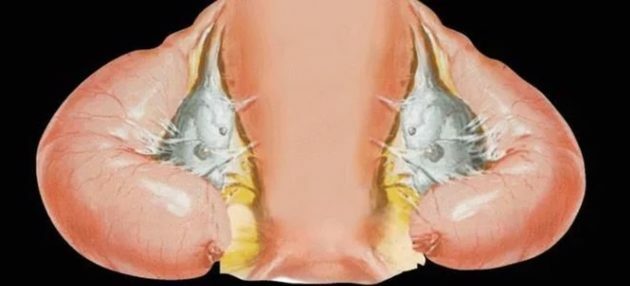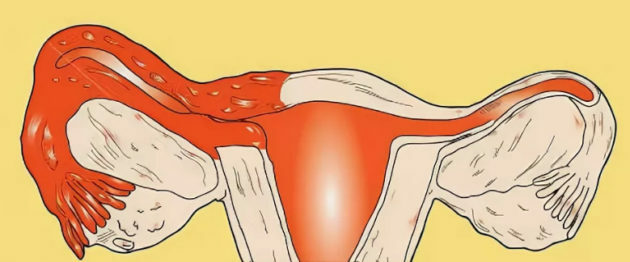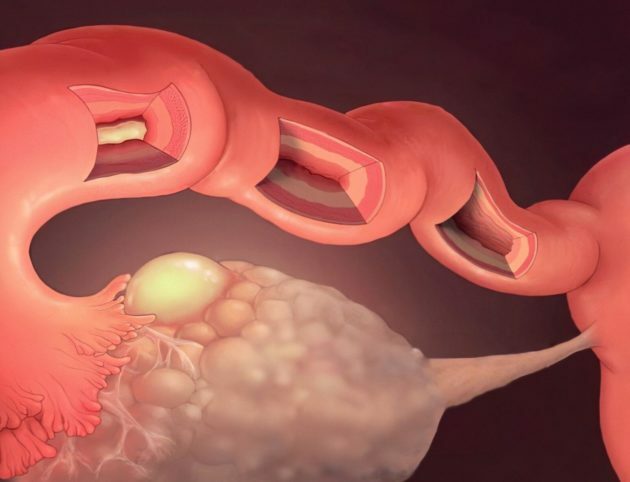Content
- 1 What is sactosalpinx in women
- 2 Causes of sactosalpinx
- 3 Symptoms of sactosalpinx
- 4 Diagnostics
-
5 How to treat sactosalpinx on the right, on the left
- 5.1 Is it possible to get pregnant with 2-sided sactosalpinx
-
6 What is the danger of sactosalpinx in women on the right, on the left
- 6.1 Can the sactosalpinx burst
- 7 Preventive measures
- 8 Conclusion
- 9 Patients' comments on the treatment of bilateral, left-sided sactosalpinx
Often, pathologies that form and progress in the fallopian tubes become the cause of female infertility. One of these is the disease sactosalpinx, which, according to statistics, does not allow 30% of women to become pregnant. The diagnosis completely disrupts the normal functioning of the fallopian tubes, which causes the inability to conceive, regardless of the age and condition of the reproductive system. Treatment of sactosalpinx is prescribed, depending on its etiology, as well as the scale.
What is sactosalpinx in women
Sactosalpinx as a diagnosis in women is a pathological condition of the fallopian tube, in which watery-type contents accumulate in the lumen of the organ. It is usually a clear, pale yellow serous fluid. In this case, they speak of hydrosalpinx. If there is an infection, then pus appears in it, and the formation itself is called pyosalpinx.
The disease can be unilateral or bilateral. According to the ICD, sactosalpinx has the code N70.1. Due to the fluid accumulated inside the fallopian tube noticeably increases in size. As a rule, sactosalpinx is a complication of another gynecological disease, the diagnosis is never primary.

When two fallopian tubes are affected at once, the diagnosis is called bilateral.
In modern gynecological practice, several classifications of sactosalpinx are accepted. For the correct diagnosis, localization, type of secretion, nature of the course, structural features of the formed sac, as well as the presence of the possibility of outflow of accumulated exudate are taken into account.
By type of secret:
- purulent;
- serous.
According to the features of the structure:
- Follicularwhen the formed bag is a few cavities spliced together.
- Simple. There is only one cavity filled with serous fluid or pus.
By localization:
- Unilateral - a delay in the withdrawal of fluid on one of the pipes, while treatment may be required both on the right and on the left.
- double sided - two fallopian tubes are involved in the pathological course of the disease at once, simultaneous treatment of the paired organ is required.
Depending on the course, the sactosalpinx can be active, represented by an acute form of the course of the disease. with pronounced symptoms, a cavity with liquid forms and reaches a large enough size fast. Chronic diagnosis or indolent develops slowly, has little to no symptoms and can at any time move into a fast phase.
Classify the pathology and the type of possibility of outflow of fluid. Permanent - when the outflow of exudate does not occur without the intervention of doctors, and ventilated, in this case, the contents of the tubes are periodically poured into the uterine cavity.
Causes of sactosalpinx
Usually, the formation and exacerbation of the sactosalpinx is caused by the narrowing of the fallopian tubes due to the appearance of adhesions in their cavity. The fluid secreted by the walls of the organs is retained, unable to exit in the uterus, and forms a kind of bag with its volume. The main reasons for this are:
- endometriosis, especially in the advanced phase;
- inflammatory processes occurring in the appendages - salpino-oophoritis, salpingitis;
- sexually transmitted diseases, including non-specific infections;
- complications arising from peritonitis;
- any unsuccessful surgical intervention - abortion, sterilization, hydrotubation, diagnostic curettage, operations for tubal infertility;
- oncological diseases of the uterus and fallopian tubes.
Indirect factors that cause unilateral and bilateral sactosalpinx are unprotected intimacy and frequent change of sexual partners.
A warning! The risk group includes patients working in conditions of constant hypothermia, as well as with increased physical exertion. These factors often lead to the formation of chronic sactosalpinx.
Symptoms of sactosalpinx
Signs of sactosalpinx are determined by the nature of the course of the disease. The chronic form of the disease often proceeds completely without symptoms until it enters the active stage. Often, this variant of the disease can only be detected as a result of a gynecological examination performed for other reasons.
However, the following signs may indicate the presence of a chronic disease requiring treatment:
- pain in the pelvic area;
- heaviness in the lower abdomen;
- small vaginal discharge, regardless of day cycles.

The chronic form of the disease is often accompanied by general malaise, which is usually attributed to fatigue.
Acute sactosalpinx, requiring immediate treatment, is determined by the following symptoms:
- Drawing pains in the lower abdomen, which can take on a pulsating character.
- Fever, chills, fever.
- Failures of the menstrual cycle, which are manifested by both delay and early bleeding.
- Increased fatigue, lethargy, general poor health.
- Watery vaginal discharge of a profuse nature that occurs regardless of the day of the cycle.
Important! The signs of unilateral and bilateral sactosalpinx are the same, only in the second case they can be more pronounced.
Diagnostics
To determine the sactosalpinx in order to prescribe medication, you can use a conventional ultrasound during a visit to the gynecologist. Additionally, it will be possible to confirm the diagnosis during a simple examination on a chair and hysterosalpigography.
How to treat sactosalpinx on the right, on the left
Primarily clinical recommendations in the treatment of sactosalpinx are in the treatment of the inflammatory process that caused this pathology. After that, surgical intervention is required. Conservative treatment of sactosalpinx involves taking antibiotics that will stop the inflammation. Preparations are selected, depending on the type of pathogen.
After the acute form of the disease is stopped, surgical treatment can begin. Most often, with sactosalpinx, the following types of operations are performed:
- Treatment of sactosalpinx by laparoscopy. This operation is called reocclusion, it is a plastic surgery of the fallopian tube, the result of which is its complete patency.
- Tubectomy. An extreme measure of surgical intervention, the use of which is indicated in the case when the plastic was ineffective or there are relapses. Pregnancy with such an operation in the future is possible only with the help of IVF.
Important! The effectiveness of surgical treatment reaches 60%, but the risk of further ectopic pregnancy remains high.
Is it possible to get pregnant with 2-sided sactosalpinx
With bilateral sactosalpinx, pregnancy is impossible, since both tubes remain impassable. The only way out is only surgical treatment to remove serous or purulent fluid.
What is the danger of sactosalpinx in women on the right, on the left
The main danger of the disease lies in the complete obstruction of the tubes and, as a result, infertility. Even if pregnancy occurs, it is highly likely to be ectopic.
Can the sactosalpinx burst
The bag with serous or purulent fluid formed in the fallopian tubes is constantly increasing in size. The result of this growth may be its complete break. The result of a ruptured sac is dangerous peritonitis, which is difficult to treat.

Peritonitis is especially difficult to tolerate and is cured in the presence of pus.
Preventive measures
As preventive measures, modern gynecological practice recommends the following methods:
- regular visits to the doctor with a preventive examination on the gynecological chair;
- responsible approach to pregnancy planning;
- testing for the timely detection of inflammatory processes and sexually transmitted diseases.
Additional prevention is the use of barrier contraception during intimacy, as well as the rejection of unreasonable invasive manipulations on the pelvic organs.
Conclusion
Treatment of sactosalpinx involves surgery with a preliminary course of antibacterial drugs. Their choice is based on the type of pathogen that caused the inflammatory process in the fallopian tubes. This diagnosis is always a consequence of another disease that must be treated first.
Patients' comments on the treatment of bilateral, left-sided sactosalpinx
Kostrova Inna, 30 years old, Krasnodar
I preferred to use homeopathic remedies for the treatment of sactosalpinx, although they are not recognized by traditional medicine. As a result, she simply lost time, the situation only worsened. I still had to take antibiotics, and then there was an operation. Fortunately, the pipe was saved. In the near future I even plan pregnancy.
Petrova Anna, 35 years old, Moscow
Unfortunately, I encountered sactosalpinx, which can only be cured surgically, already at a late stage of its development. The bag with pus was large enough, it was impossible to hesitate, I was immediately operated on. The fallopian tube could not be saved. Fortunately, it was one-sided, the second organ is in place and fully functioning.
Martynova Irina, 27 years old, Krasnoyarsk
For a long time I did not dare to have an operation, knowing that I had a bag with serous fluid in the fallopian tube. He did not cause me discomfort, the doctor put the chronic stage of the disease. However, I was planning a pregnancy when it turned out that an unpleasant pathology had also affected the second pipe. I had to urgently undergo an operation in order to restore reproductive functions later and not resort to IVF.
The information and materials on this site are provided for informational purposes only. You should not rely on the information as a substitute for actual professional medical advice, assistance or treatment.
